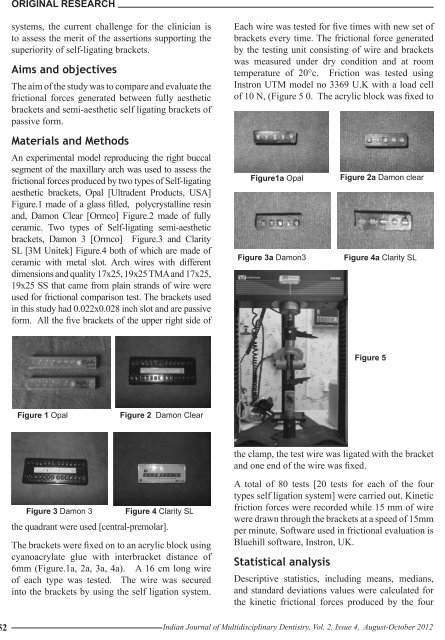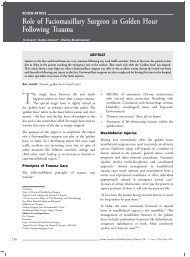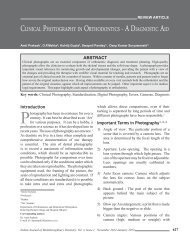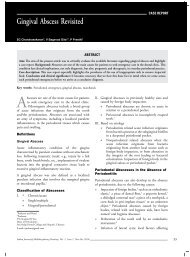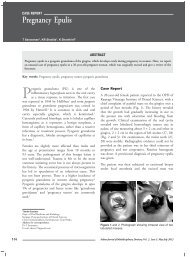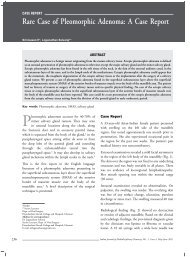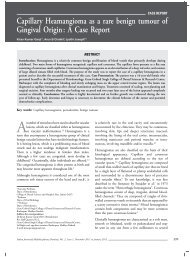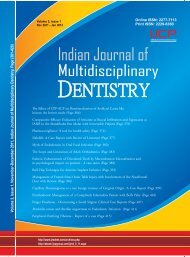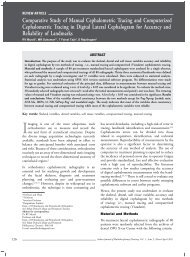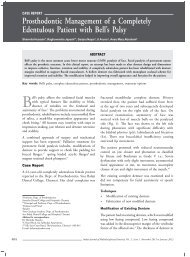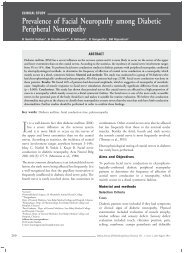Volume 2 - Issue 4 (Aug-Oct) Download Pdf - IJMD
Volume 2 - Issue 4 (Aug-Oct) Download Pdf - IJMD
Volume 2 - Issue 4 (Aug-Oct) Download Pdf - IJMD
- No tags were found...
Create successful ePaper yourself
Turn your PDF publications into a flip-book with our unique Google optimized e-Paper software.
Original Researchsystems, the current challenge for the clinician isto assess the merit of the assertions supporting thesuperiority of self-ligating brackets.Aims and objectivesThe aim of the study was to compare and evaluate thefrictional forces generated between fully aestheticbrackets and semi-aesthetic self ligating brackets ofpassive form.Materials and MethodsAn experimental model reproducing the right buccalsegment of the maxillary arch was used to assess thefrictional forces produced by two types of Self-ligatingaesthetic brackets, Opal [Ultradent Products, USA]Figure.1 made of a glass filled, polycrystalline resinand, Damon Clear [Ormco] Figure.2 made of fullyceramic. Two types of Self-ligating semi-aestheticbrackets, Damon 3 [Ormco] Figure.3 and ClaritySL [3M Unitek] Figure.4 both of which are made ofceramic with metal slot. Arch wires with differentdimensions and quality 17x25, 19x25 TMA and 17x25,19x25 SS that came from plain strands of wire wereused for frictional comparison test. The brackets usedin this study had 0.022x0.028 inch slot and are passiveform. All the five brackets of the upper right side ofEach wire was tested for five times with new set ofbrackets every time. The frictional force generatedby the testing unit consisting of wire and bracketswas measured under dry condition and at roomtemperature of 20°c. Friction was tested usingInstron UTM model no 3369 U.K with a load cellof 10 N, (Figure 5 0. The acrylic block was fixed toFigure1a OpalFigure 3a Damon3Figure 2a Damon clearFigure 4a Clarity SLFigure 5Figure 1 OpalFigure 2 Damon Clearthe clamp, the test wire was ligated with the bracketand one end of the wire was fixed.Figure 3 Damon 3Figure 4 Clarity SLthe quadrant were used [central-premolar].The brackets were fixed on to an acrylic block usingcyanoacrylate glue with interbracket distance of6mm (Figure.1a, 2a, 3a, 4a). A 16 cm long wireof each type was tested. The wire was securedinto the brackets by using the self ligation system.A total of 80 tests [20 tests for each of the fourtypes self ligation system] were carried out. Kineticfriction forces were recorded while 15 mm of wirewere drawn through the brackets at a speed of 15mmper minute. Software used in frictional evaluation isBluehill software, Instron, UK.Statistical analysisDescriptive statistics, including means, medians,and standard deviations values were calculated forthe kinetic frictional forces produced by the four552Indian Journal of Multidisciplinary Dentistry, Vol. 2, <strong>Issue</strong> 4, <strong>Aug</strong>ust-<strong>Oct</strong>ober 2012


